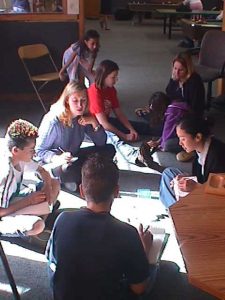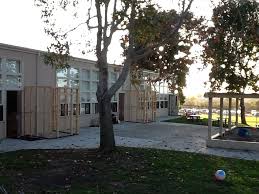In Chapter 7, we briefly described the initial design of an activity for elementary school children attending an after-school program where it was hoped that we could engage them in academically valuable pursuits. It arose again as a topic in organizing joint research with Russian developmentalists and communications scholars. In this chapter, we take up the use of that system, dubbed “The Fifth Dimension,” (often shortened to the 5thD) as a means of studying basic issues in learning, teaching, and development and as a means of understanding the circumstances under which such activities can be sustained.
By the end of the research described in Chapter 7, we judged the 5thD to be a marked improvement over the kinds of activities routinely engaged in as part of the after school lives of children. There were improvements with respect both to the acquisition of academic skills and to the socio-emotional predispositions to participate in activities where print mediated the activities — and they were enjoying it. Feedback from parents was quite positive. Initially suspicious, the teachers reported that several of our children showed improved performance in the classroom. Moreover, kids kept on coming, improving their ability to deal with a wide range of appropriately challenging academic tasks.
At this point, the 5thD became an object of intense interest to us. Kids liked it, adults responsible for children outside of school seemed to like it, and we liked it both as a way of studying new ways to engage children with intellectual matters and because it proved to be a rich medium for research on into general issues of learning, culture, development and instruction. We also were impressed by the enormous impact that participation had on the undergraduates who participated in the activities as an apprenticeship in research.
For the next few years we sought funding from the National Institute of Health to continue the work. However, the shift in methodology we had adopted in 1982 — immersion in the 5thD as a simultaneous means of diagnosis and medium for remediation — seemed too clinical by some committees, or insufficiently experimental/too deviant in its mixing of ethnography and experimental psychology by others. It was too applied for the NSF, for example, yet too basic for the Bureau of the Educationally Handicapped, which had supported the initial work.
To our good fortune, we found support for our work from private sector foundations. One such organization was the Carnegie Corporation, which had supported earlier research at LCHC in our efforts to design new modes of reading instruction incorporating computers and computer networks. They also were interested in our methodological approach that brought together scholars from several different social sciences to wrestle with understanding how it can be that normally developing children find learning to read, let alone acquiring a disposition to read, an insurmountable task. In addition, Carnegie also supported efforts to link this general question to the very specific issue of ethnic and social class inequalities in academic achievement. In addition, the support of the Spencer foundation, which was interested in issues of technological change and education as well as our focus on out-of-school time as a resource for educational improvement, also proved essential in those earlier days and throughout the first decades of the project.
Using a compilation of such resources, the 5thD Project was officially launched. When the 5thD re-emerged during the 1986-1987 academic year, the project had the essential features of its canonical forbearer and a new identity. It was now a “successful educational innovation,” born as part of a project on understanding the phenomenon known as a “learning disability” at a time when the public was fascinated by the potential and perils of computer games for children. Over the subsequent 30 years, it became the incubator for a great many of the Lab’s continued efforts to come to grips with the social creation of educational inequalities as part of an increasingly broad approach to understanding the role of culture in human development.
The Fifth Dimension as a Tool of Research
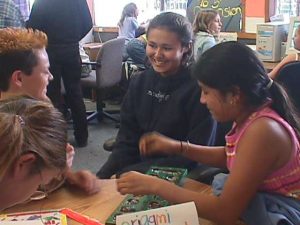 We pursued several goals when we once again took up the 5thD as an object of research in 1986. The American educational community was abuzz with concerns that the US was a “nation at risk,” and educational researchers were spending a lot of time and effort trying to figure out how to get American children to spend “more time on task” (Cole, Griffin, & LCHC, 1987). Despite professional and policy concerns, it was not clear how to get children to sit longer at their desks or to do more homework. Nor was the public sufficiently concerned to vote for a longer school day or a longer school year.
We pursued several goals when we once again took up the 5thD as an object of research in 1986. The American educational community was abuzz with concerns that the US was a “nation at risk,” and educational researchers were spending a lot of time and effort trying to figure out how to get American children to spend “more time on task” (Cole, Griffin, & LCHC, 1987). Despite professional and policy concerns, it was not clear how to get children to sit longer at their desks or to do more homework. Nor was the public sufficiently concerned to vote for a longer school day or a longer school year.
We knew from our earlier research with the 5thD, as well as collateral research by other members of LCHC, that there are a variety of ways to attract children and involve them in intellectually engaging, academically relevant activities after school. But we did not know what the potential reach and variety of such activities were, either with respect to potential host community institutions, child populations, or specific kinds of activity.
Based upon our prior experience with the 5thD, we thought it provided a potentially effective attractor of children who could benefit from “more time on task,” while at the same time allowing us to investigate any special qualities of instruction that might be provided by computer mediated activity in the after-school hours.
The way in which we summarized our goals at the time is a direct implementation of the cultural practice approach to understanding culture and development discussed in Chapter 8. However, in this case we wanted to go beyond bits and fragments of evidence to make our argument. We were seeking a way to provide a convincing empirical evaluation of our analysis in these terms (see the Spencer Grant Proposal of 1986):
1. To research the power of a cultural practice theory to engineer effective reorganizations of educational activity within a variety of community and school contexts.
2. To investigate the power of communication between sites as a method of fomenting within-context change.
3. To create a new kind of educational activity system that could be taken up and maintained by the community with its own resources.
Each of these goals will be important to the narrative that follows. The issue of sustainability deserves special attention, because while a basic issue in our proposal, we were least prepared to deal with it methodologically, theoretically, or practically. In particular, we were committed to studying the devolution of the system, the process of failure to sustain. At the start, sustainability was a distant, imagined, state of affairs. So in the early years of the project, it was difficult to think about sustainability theoretically – everyone was very involved in the doing and documenting. At the time of this writing, however, the question of how to think about sustainability has become central to the project of the 5thD.
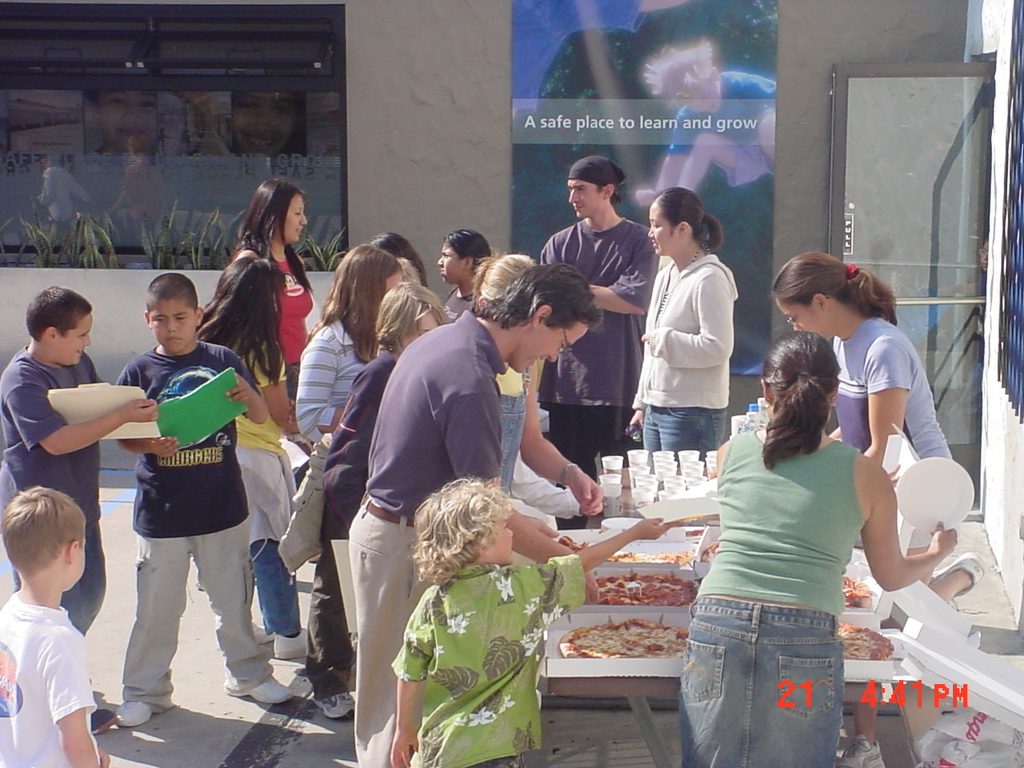
The Value of Focusing on Sustainability
As recounted elsewhere, Cole’s interest in the issue of sustainability as a goal of educational reform was piqued by early work in West Africa (Chapter One). During the interval where we were searching for funds to continue research on the 5thD, our interest in sustainability was rekindled because LCHC had been commissioned to write a monograph for the National Research Council (NRC) to identify barriers to the participation of women and minorities in technological fields of study. While immersed in gathering information for the report, an NRC staff member sent the group a report prepared by the American Association for the Advancement of Science (AAAS) about successful technological education programs targeting women and minorities, the very topic we were supposed to be researching (AAAS, 1984). The report identified 16 characteristics of the successful programs, which, if implemented indicated that “if minorities and women are provided early, excellent and sustained instruction in these academic areas…then their achievement levels parallel those of white males” (AAAS, 1984, p. iv).
We could not help asking ourselves why our report was necessary given that the answers we were seeking were presumably known. Why were new programs, many of which lacked the essential characteristics identified in the AAAS report being reinvented every year, including programs at our own universities? Why, in short, were proven and effective programs not sustained?
The simple answer in both the American and Liberian cases seemed to be that the successful programs could not be integrated into the normal operation of existing social institutions because they required extra effort in terms of creating the conditions that enabled a sufficient proportion of those 16 success markers to be present. Such “admirable experiments” were tolerated by the social institutions where they were developed only so long as they “paid their own way.” When outside funding dried up, they could not compete successfully for internal resource demands that were given higher priority than inclusive education.
Here was a new challenge. If we could demonstrate the effectiveness of the 5thD and have it win acceptance in a host institution, could we do so in a way that was sustainable over the long haul? As Cole (1996) later posed the question:
“Obviously all innovations don’t go away. Some come and stay for a long time, such as the use of IQ-like tests as measures of academic achievement or Thorndikian drill and practice methods to teach basic academic skills. What are the factors involved in the process by which an innovation is taken up or rejected, even if it fulfills society’s expectations of it?” (p. 288).
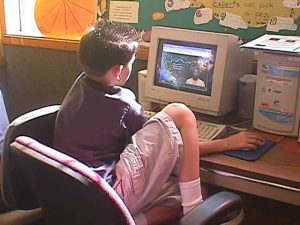 A research plan was born. We would create several after-school computer-mediated programs modeled on the original 5thD in different institutions that hosted children during the after-school hours. These activities would provide the highly desired trait of more time on academic tasks. We would run a practicum course in child development at UCSD as a source of “older peers” to provide academically able and motivated personnel to enrich the after-school settings and opportunities for creating zones of proximal development. We would trace each system over time to observe the processes of development that we were attempting to create and sustain. During this same period, we would learn as much as we could about the history of the institutions we worked with, including their current organization and practices. In this sense, we were concerned with the “activity” (the 5thD) studied in its “context” (its institutional center, the place of that center in its community, and the place of that community in the larger, regional social order).
A research plan was born. We would create several after-school computer-mediated programs modeled on the original 5thD in different institutions that hosted children during the after-school hours. These activities would provide the highly desired trait of more time on academic tasks. We would run a practicum course in child development at UCSD as a source of “older peers” to provide academically able and motivated personnel to enrich the after-school settings and opportunities for creating zones of proximal development. We would trace each system over time to observe the processes of development that we were attempting to create and sustain. During this same period, we would learn as much as we could about the history of the institutions we worked with, including their current organization and practices. In this sense, we were concerned with the “activity” (the 5thD) studied in its “context” (its institutional center, the place of that center in its community, and the place of that community in the larger, regional social order).
With funding in place, we began. Diagnostically, whatever goal formation had gone on during the initial planning workshops, little was in evidence. The local elementary school decided not to go ahead with their involvement because they feared for the safety of their computers. They offered to help the Childcare Center instead. The Boys and Girls Club (BG Club) and local library personnel had enjoyed the 5thD and thought their kids would like it too. The library personnel expressed the hope that the project could be done in a way to involve the children with library functions, and we agreed it was a good idea. Then the process of development and attrition began.
Each site followed its own emergent path of development. At the end of four years, only the BG Club 5thD was continued. The Childcare Center and the Library each dropped out of the program in an institutionally specific way and for very different reasons. The BG Club continued for equally specific reasons that made continuation attractive for the Club, despite the need to pay more of the costs of the program.
Childcare Center
The first 5thD to expire was at the Childcare Center, where our activities continued only 2/3 of the 1987‑1988 academic year. The demise of the Childcare Center’s 5thD was not the result of the failure of the activity to please the children or the staff. In fact, not long after starting the program we were asked to modify our procedures to allow all of the kids a chance to participate.
The stress point that led to the demise of the 5thD at the Center was fear of child abuse combined with the relatively rapid turnover of undergraduates (UCSD classes run for only 10 weeks a quarter). As a result of publicity surrounding an alleged child abuse case in Los Angeles and a high level of concern about child abuse more generally in the US, the agency that licensed the Childcare Center insisted that all adults working in a daycare facility register their fingerprints with the Department of Justice and obtain a tuberculosis test. Money was not a problem, but time was. The quarter was well under way by the time all the paperwork was completed, and the undergraduates could go to the site. As a consequence of these complexities, the Center’s Director was grateful when we suggested, prior to the start of the third quarter, that we suspend the project.
The Library
The Library 5thD was located in a back corner of the town’s library. When it was not in session, the computers, the maze, and other paraphernalia were stored in an adjacent closet. Because it was located across a freeway from the elementary school, children who attended the Library 5thD were generally dropped off and picked up by their parents, and it took a few weeks for the new activity to catch on. By midway through the first quarter, we had a steady complement of 6-7 children attending twice a week. In the second year, we accommodated increased demand by running two shifts of the 5thD for an average of 8-9 children per session, four days a week.
Despite its small size, the Library 5thD was the most successful of our systems from the perspective of its impact on the children (Nicolopolou and Cole, 1993). UCSD undergraduate students and the children formed close personal bonds. Interactions at this site were marked by the high level of task involvement that developed among the children and the undergraduates and corresponding higher indices of learning.
From early in the project, we worked with the Library staff to build expertise in the running of the 5thD and we helped them raise money locally to begin the process of providing hardware and software. We created special 5thD activities that required the children to acquire library skills, and we met with the staff periodically to review progress in the program. The librarian was helpful in seeing that a phone line was placed near the 5thD to facilitate communication with the Wizard, the amiable patron of the activity who communicated with the children.
At the end of the third year of the project, we met with the staff at the Library to discuss the future. We could guarantee that students would keep coming (because Cole could teach the classes or arrange for someone else to), but we could not continue to provide a site coordinator, and we could not be responsible for computer upkeep, purchases, etc. The local Friends of the Library agreed to pay for a site coordinator and upkeep, but the Library staff decided that they did not want to continue the program. There were many reasons for this decision: the Library was short of space, the children sometimes got noisy when they became excited about a game they were playing, there were administrative difficulties in handling the money needed to pay a site coordinator, they did not have time to train people to work with the children, etc. Each of these problems could have been solved, but the fact of the matter was that the librarians had come to the conclusion that the 5thD did not fit closely enough with their main goals as librarians. And so that was the end of the 5thD in the Library.
The Boys and Girls Club
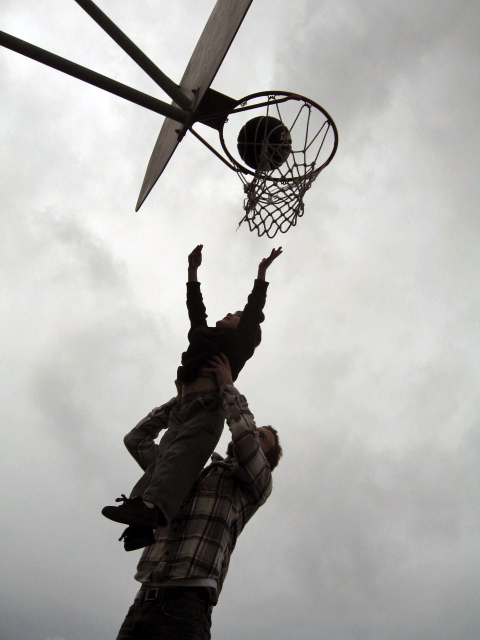
The 5thD at the BG Club took place in a large room that well exceeded our initial, modest capacities to accommodate children. We slowly added to our 4-5 computers, and undergraduates came in larger numbers, so our capacity to handle more children increased. As soon as we had the person power, we kept the program open four days a week. Since the space was not being shared with other programs, we had the luxury of leaving things set up between sessions. We could also put the maze in a prominent place in the center of the room and put children’s artwork and posters relevant to 5thD activities on the walls.
The number of children attending the 5thD fluctuated wildly from a low of 4-5 to a high of 12-13. In accordance with the norm of the Club, children came and went as they pleased. Some came only once a week, while other were habitués, depending upon their life circumstances and interests. Children would come, spend a while in the 5thD and then leave to participate in other Club activities. The rapid flow of children, both within and between days, made it difficult for children and undergraduates to get to know each other. The undergraduates and researchers found it difficult to keep track of which games children had completed at each level. These conditions made it difficult for the undergraduates to grasp and make use of the rules and conventions they and the children were supposed to follow. Consequently, some children (and undergraduates) felt that the rules were coercive and external to them, so they either resisted or ignored them.
These difficulties were sufficient to induce us to try to various strategies to simplify the operation of the 5thD, but our attempts were a total failure. Before long, the children settled into playing whatever games suited their fancy at whatever level. The undergraduates themselves started to introduce new rules, but these were not related to each other, and everyone felt they were arbitrary and unproductive. However, the children kept coming, the Club personnel were pleased, and the students continued to sign up for the class.

That summer, we ran a special summertime 5thD at the BG Club in which we returned to the original 5thD structure, elaborating new artifacts to deal with the complexities of the BG Club setting (record keeping devices, a carefully worked out organization of the games within the maze, and improving task cards, for example). When the 5thD reemerged in its elaborated form, it proved a gratifyingly sturdy tool.
I want to emphasize the point that whatever our discontent with the 5thD, the children kept coming and the adults in charge were pleased to have the program. During the second year, ambitious undergraduates opened a new 5thD in one of the neighboring BG Clubs, and soon thereafter a third BG Club asked for and got a 5thD. The Clubs gave the program an award and embraced it as an important new addition to their program. Most importantly, they provided the needed support for computers and telephone lines.
When we met with the directors of the initial BG Club at the end of the third year, they were committed to continue the program. They did not shy away from picking up responsibility for paying a site coordinator part time, and they had already started to provide the needed support for computers and telephone lines. When the recession of the early 1990’s caused cutbacks at the clubs and at UCSD, we cut back to the “main” 5thD at the original BG Club.
Following the official end of the project, the 5thD at the BG Club continued to serve as a source of inspiration through which to address the theoretical issues we were anxious to put to the test. The practicum class continued to be taught at UCSD, and we continued to send undergraduate students to the 5thD at the BG Club. We had reached a kind of plateau where we could focus heavily on the work needed to keep the activities developing in a healthy way and in documenting the changes we were (and were not) observing. We wrote articles about what we were seeing, and we sought financial support to continue our efforts.
A Foreign Fling with the Fifth Dimension
As part of the Velham Project, in the summer of 1987 an international team of Soviet and American developmental psychologists/educators succeeded in conducting a special summer camp not far from Moscow and a paired camp in San Diego (see Chapter 10). During this time, we were able to institute a version of the 5thD including the potential for the kids to interact via a store-and-forward messaging system. The child-to-child correspondence ranged from comparative strategies about how to win at a commonly experienced game to more personal exchanges involving various kinds of cultural display, including riddles, poems, and comparisons of favorite objects. The adult discussions were also useful. Scholars on the two sides jointly discussed a wide range of topics including the strengths and weaknesses of various software the children were being exposed to, optimal ways of organizing interactions between the children and particular games, and strategies to take advantage of telecommunications in order to stimulate children’s active engagement in learning and communicating.
From approximately the fall of 1989 to the beginning of the 1990-91 academic year, we conducted a wide range of studies in and around the 5thD that complemented work we had already begun in the United States. We placed a high premium on being able to motivate child-to-child correspondence. The internet was still too primitive to allow transmission of video cheaply, so we complemented 5thD engagement with various projects to engage the children’s imaginations about each other’s lives and common problems, such as the armed conflicts that broke out in both Estonia and Iraq (see, Edwards, 1990 and Mirror Gazetta, 1991).
Overall, we learned a great deal about how difficult it could prove to organize child-to-child correspondence outside of school-like settings, sometimes succeeding and sometimes failing. Having a reliable foreign partner also allowed us to separate problems in organizing collaborative activities across sites within a country (and shared language) from complications arising from unshared language and time delays between opportunities for communication (American sites specially organized in a Chicago housing project, a New York Community Center, a working class suburban New Orleans after school program, and a Southern California free school).
The Velham project advanced our research agenda in several ways. First, vis-à-vis our ability to do interesting design work, we were fortunate to create a unique international team. This team included a private American software company, Soviet computer scientists and developmentalist-educators who collaboratively redesigned a popular program for teaching children to create algorithms in a manner that mixed Soviet and American ideas on maximization of the program’s potentials (Griffin, Belyaeva, Soldatova, and the Velikhov-Hamburg Collective, 1993).
With respect to sustainability issues, the matter was more complicated. The existence of the 5thD in Moscow was always something of an anomaly, kept together by the project directors on the two sides within the political agenda of the late Soviet era and in particular, Velikhov and Hamburg. The VelHam project enabled us to engage others in pursuing our common research goals, and it certainly made our work visible. At the same time, it fell outside of the scope of our sustainability analysis because of its direct, politically entangled origins. However, it had a marked impact on the sustainability in the US.
The Unexpected Proliferation of Fifth Dimensions
We have just noted that in order to find a common scientific object that could organize socially acceptable collaborative research between Soviet and American educationalists and developmentalists, three 5thD replicas were created in three new settings. Each setting provided important data for our overall investigation of how the qualities of the 5thD emerge from the process of its implementation in different social, cultural, economic, and institutional circumstances. Significantly, one of the new sites, the La Jolla Children’s School, took place during school hours — a break from the past tradition of placing 5thDs only in the after-school hours. In fact, the 5thD became, for two years, the “computer curriculum” for the school, which believed strongly in the importance of mixing play and education in the schooling process and at the same time was anxious for the children to become citizens of the world. Oddly, for us, many of the school personnel thought the 5thD was too much like school for their taste!
This arrangement suited perfectly our needs for children to be regularly present in order to engage through the Internet with children from different parts of the US, but especially the children from Moscow. Because of its proximity to UCSD, we were able to reduce the turn taking time between receiving and sending notes back and forth in email to less than a day. One effect of this arrangement was to allow us to test the limits of internet mediated communication among children speaking different languages (Edwards, 1990).
While our attention was focused on the Children’s School, the 5thD at the BG Club continued to function in what we came to think of as its “feckless ways” — the activities were more educationally engaging than ordinary afterschool programs but less educational than we thought deserving of the status as a “successful educational innovation.” But survive it did.
Most surprisingly, it not only survived, but it began to evoke requests from nearby BG Clubs to start 5thDs of their own. In addition, to our surprise, it spontaneously gave rise to new 5thDs in the immediate geographical area. Two of these efforts were relatively short-lived. In one case, traffic problems made it too time consuming for undergraduates to reach the site. In the other case, local budgetary cutbacks reduced the staffing and available space to the point where the program could not maintain its distinct character.
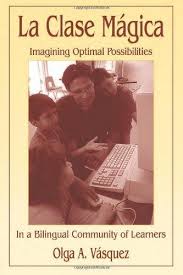 However, one new site, which over the years played a central role of the development and sustainability of the 5thD project was begun by Olga Vasquez, who came to UCSD as a post-doctoral fellow in 1989. Olga arrived at a point in the implementation of the 5thD at the BG Club when we had been spending a lot of energy and student ingenuity on what we considered a glaring shortcoming of the BG Club: It did not attract the relatively large number of Latino children attending the local elementary school. We were not succeeding in a solution.
However, one new site, which over the years played a central role of the development and sustainability of the 5thD project was begun by Olga Vasquez, who came to UCSD as a post-doctoral fellow in 1989. Olga arrived at a point in the implementation of the 5thD at the BG Club when we had been spending a lot of energy and student ingenuity on what we considered a glaring shortcoming of the BG Club: It did not attract the relatively large number of Latino children attending the local elementary school. We were not succeeding in a solution.
Olga arrived from Stanford where she been conducting research on children’s learning both in a variety of neighborhood and family settings as well as in a computer activity for girls organized by Shirley Brice-Heath. Instead of writing up her thesis, as she had expected to do, she got caught up in the idea of starting her own form of 5thD, one that was specifically designed for the Mexican community half a mile away from the BG Club.

The result was La Clase Magica, the goal of which was to create an ideal learning environment that integrated its activities with its local community in such a way that it might be able to sustain itself if, as she expected that she would be going away before long. Contrary to that early expectation, Olga remained at LCHC as a faculty member and played a central role in the development of the 5thD project.
Beyond UCSD, national and international interest continued to grow, and the 5thD project expanded with sites in many locations both nationally and internationally. To follow this story, read more at the Projects Page and 5thD Adaptations Page.
Chapter Eleven Compositor: Mike Cole
Additional contributors to 5th Dimension Research included Sonja Baumer, Lia DiBello, Margie Gallego, Viktor Kaptelinin, Ageliki Nicolopoulou, Amy Olt, Claire Ramsey, Crystal Shannon-Morla, and Lisa Tripp.
Note: This chapter condenses descriptions of the 5thD, the original sources of which begin to appear in the early 1980s. For those with a special interest in this project, visit the 5thD projects page, where background materials and videos can be found. Analysis of data from the 5thD project is still a work in progress in 2017.
Back to Chapter 10
Forward to Section Five
